Cloud Automation Journey White Paper
Available Languages
Bias-Free Language
The documentation set for this product strives to use bias-free language. For the purposes of this documentation set, bias-free is defined as language that does not imply discrimination based on age, disability, gender, racial identity, ethnic identity, sexual orientation, socioeconomic status, and intersectionality. Exceptions may be present in the documentation due to language that is hardcoded in the user interfaces of the product software, language used based on RFP documentation, or language that is used by a referenced third-party product. Learn more about how Cisco is using Inclusive Language.
IDC’s worldwide cloud 2021 predicts enterprise cloud architects will recognize that operational complexity is reaching a breaking point. ITOps, DevOps, and CloudOps teams will struggle to maintain service levels, manage costs, and ensure security and compliance across loosely coupled hybrid and multicloud architectures spanning private clouds, public clouds, hosted clouds, and traditional datacenters and edge systems.
Hybrid and Multicloud control planes rely on API integrations to underlying cloud-specific configuration, provisioning, and monitoring tools and allow enterprises to change out cloud-specific resources even as policies and service levels remain stable.
We introduce Cloud Automation Journey as a SaaS based architecture for consuming IT infrastructure as a service. It doesn’t matter where the actual resources are located, they will be provided per the business logic and best location to place workloads, taking into consideration, performance, security, cost, reachability, and durability.
This thought leadership paper explains how cloud vendors and consumers can leverage the proposed “Cloud Automation Journey” as a flexible SaaS approach that simplifies the operational complexity in cloud adoption.
Cloud Automation Journey is a comprehensive SaaS based Architecture to manage the networking, security and operations of cloud-native applications and services running in any location in multicloud, hybrid or at the edge. The outcome is a consistent and a consumable model based on a simplified automation journey to overcome the technology and business challenges.
The proposed approach standardizes the consumption of policy-driven, automated multicloud architectures that abstract away underlying cloud-specific dependencies via deployment of standardized, cross-cloud governance, control APIs, marketplace and service exchange designed for flexible, dynamic connected cloud operation.
There are large number of use cases and associated Cloud-native application consumed from private cloud, edge and public cloud environments. Cloud-native applications fully take advantage of the distributed, scalable, flexible nature of the multicloud environment to maximize the focus on writing code and creating business value. Cloud automation is the use of technology that performs tasks with reduced human assistance in order to reconcile cloud management processes.
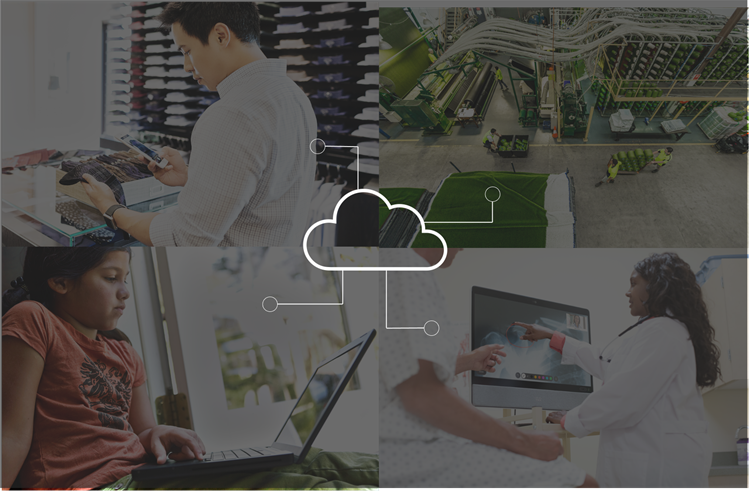
The role IT departments play for organizations is changing from a department that serves the business to one that drives the business. IT teams are becoming more tightly integrated into business units in order to provide the technology and operations needed to support fast paced user expectations. At the same time, new roles of cloud architects and excellence teams are emerging, so moving from a maintenance model to an innovation model is no longer a goal, but a necessity.
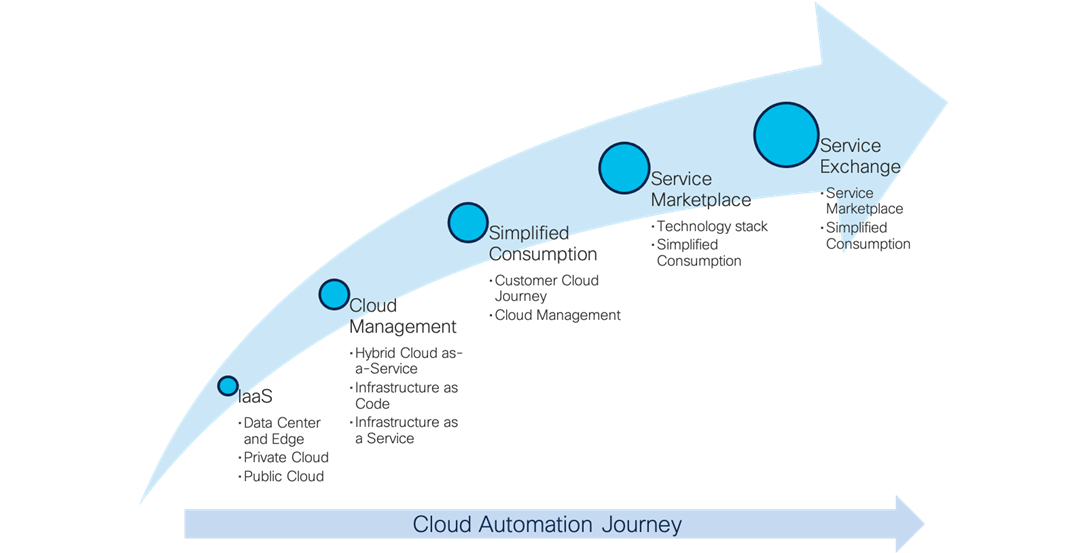
Figure 1 Cloud Automation Journey milestones
Each step of the Cloud Automation journey illustrated in Figure 1 provides an automation tier that is pluggable and independently consumable, making the Cloud Automation Journey both fully integratable, and with a flexible adoption model.
The Cloud Automation Journey describes the building blocks required to achieve a fully automated multicloud, in order to sustain and grow your business through the demands of new technologies.
We introduce Cloud Automation Journey illustrated in Figure 2 as a SaaS based architecture for consuming IT infrastructure services as a service. It doesn’t matter where the actual resources are located, they will be provided per the business logic and best location to place workloads, taking into consideration, performance, security, cost, reachability, and durability, which in turn will help drive CAPEX spending shift to manageable OPEX.
Next section covers in-depth the Cloud Automation Journey, its building blocks, capabilities and challenges it meant to solve.
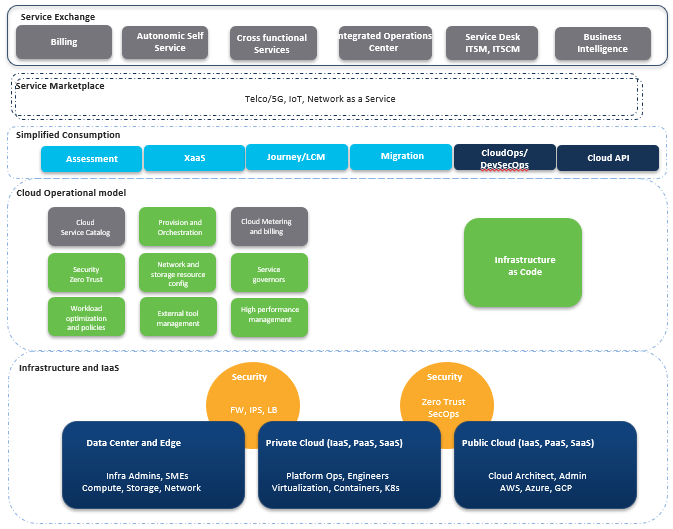
Figure 2 Cloud Automation Journey
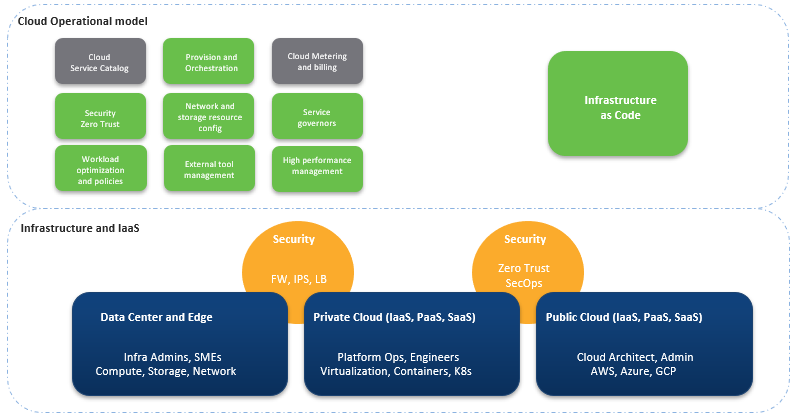
Figure 3 Cloud Management
Cloud Automation Journey enables a drop-in architecture with a flexible consumption model to allow you adopt and leverage cloud technologies across architectures which seamlessly integrate into your operations, business and chargeback systems across Hybrid and multicloud.
Cloud Operational model describes capabilities which will be consumed through the cloud lifecycle of Use, Operate and Manage. Cloud management, defined by Gartner as a Cloud Management Platform (CMP), addresses the IT Operations aspects of adopting cloud technologies as centrally managed, flexible and consumable capability across the organization, providing hybrid, multiclouds as a central core with managed and controlled risk, cost and speed.
With IT Operations providing the core cloud adoption journey, development teams and DevOps personas would value and embrace the Infrastructure as Code (IaC) capability of the provided Cloud infrastructure, this shift to IaC will drive cloud adoption to not just be an infrastructure but a beating heart for future services and offerings. The IaC is a key part of Cloud Operation model.
Organizations requires a repeatable, accessible, predictable and trackable infrastructure in order to automate the provisioning, configuration and deployments no matter the scale. IaC bridges the multi-cloud complexity by providing a declarative approach to request a desired state infrastructure, while complying with Cloud Management service policy and governors.
Cloud management constitute capabilities which combines a set of features or modules, enabling organizations to manage multi-cloud environments (private, public and hybrid clouds) and consume them as code.
Some of the capabilities provided by this layer include:
Self-service: Portal interface to manage infrastructure from, providing a list of configuration templates to execute deployments.
Provision and Orchestration: An automation capability to execute workflows and processes of updating images and configuration.
Metering and billing: Provide information on infrastructure consumption and billing. This is a key advantage of Cloud Operational Tier, which provides cost visibility and track utilization trends for IaaS: when was it most loaded? What time of the day? Which day of the month? What time of the year? Which client? then adapt business policy and IT with telemetry in hand.
Workload optimization and policies: Infrastructure optimization engine that constantly measure usage and provide recommendation per management policy.
External tool management: Centralize data center technologies in one interface, helps simplify the cloud consumption and automate its continuous delivery.
Service catalogs: centrally consolidate all service templates and their monitoring and execution.
Network and storage resource configuration: Single pane inventory and management for the complete infrastructure, will provide complete dependency and relational topology across resources.
Service governors: Analyze requests in order to deploy them with the right configuration and guide the request where it must be. Taking into account all regulation parameters, analyzes and makes sure operations are performed as desired.
High performance management: Gathering and correlating all policies, from services to your infrastructure pattern use, it will provision, configure automatically and deploy services using the right number of resources. Intelligence gathers all the data points into one account to guarantee performance and SLAs, to make the best out of user experience and satisfaction.
Zero Trust: Securing all access across your networks, applications, and environment. It helps secure access from users, end-user devices, APIs, the Internet of Things (IoT), microservices, containers, and more.
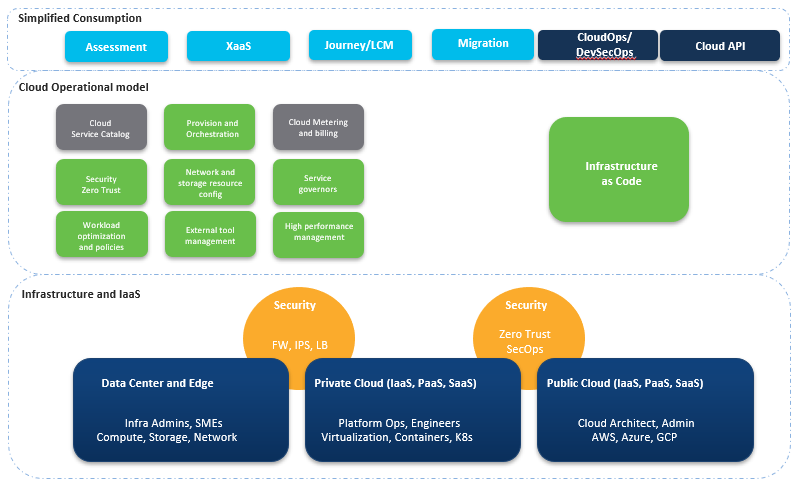
Figure 4 Simplified Consumption
Cloud Automation Journey now makes a significant leap forward from manageability of the multicloud environments, providing key capabilities for the business continuity and future expansion of the cloud technology on top of multiple infrastructure variations, and providing a single-entry point for all cloud manageability. If we look at automation capabilities, these will require the Cloud Operations tier to be an integral infrastructure by its own to higher Journey cross-architectures and business logic.
Simplified Consumption tier serves as mediation layer and API integrations relay of underlying cloud configuration, provisioning, and monitoring to the business logics and cross-architectures adoption.
CloudOps, as an expansion of DevOps, helps to achieve business, cultural, and technical goals when deploying, building, and delivering cloud services. Using Simplified Consumption modules, CloudOps provide automation capabilities around deployment, SDLC integration, adoption journey, and a flexible and simplified cloud consumption model.
The Simplified Consumption tier eases the cloud adoption across your business and technologies to consume Cloud as an end solution suitable to the way you want it, it will provide the following capabilities as minimum:
· Cloud API – Simplified API consumption for development, deployment, optimization, security and billing lifecycles allowing simple integration to other tools APIs interacting with cloud payloads.
· XaaS - Flexible and simple consumption and pricing model to best suit your business, variations can be either perpetual, annual/monthly subscription or pay per use to deliver Cloud capabilities as a service.
· Lifecycle - Onboarding cloud consumption onto an adoption journey, hand holding and providing needed guidance and telemetry for you to be on top of your cloud.
· Assessment - Policy driven recommendation engine highlighting compliance, cost and budgeting recommendations for multicloud deployments and usage.
· CloudOps – Provide continuous operations to run cloud-based systems closely with development and deployment lifecycles(DevOps).
· Migration - Assess, plan and execute on multicloud adoption through migration of app and/or services.
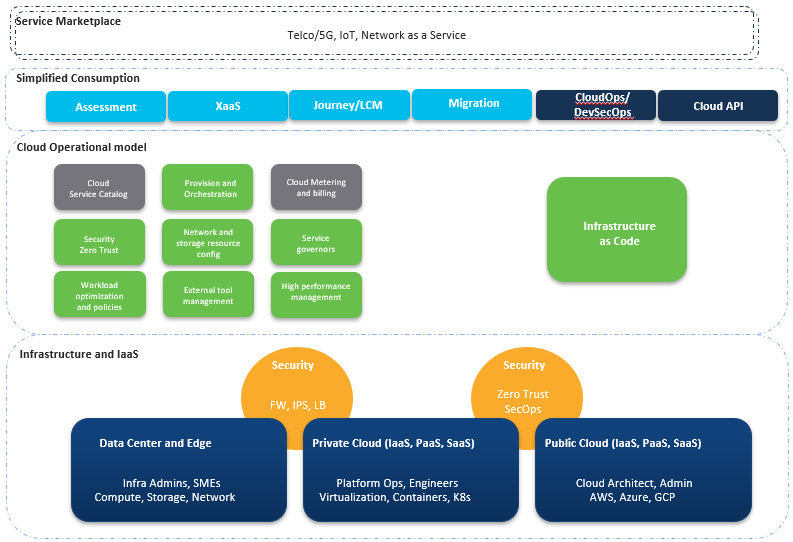
Figure 5 Service Marketplace
Emerging technologies like 5G, IoT and/or NaaS revolutionize the network. 5G is the perfect example of technology that disrupt multiple communication and compute industries we know today. The combination of 5G, IoT and cloud technologies will enrich the capacity, functionality, and flexibility that will allow network carriers to offer competitive services. Cloud Operational tier is the foundation for multicloud consumption and scaling, followed by Simplified Consumption tier that enable cloud-services utilization and consumption by the vertical “Service Marketplace” applications.
The Service Marketplace provides a flexible pick and choose capability to gain specific service that is across architecture verticals. It simplifies the ordering and dependency of how service components are captured, maintained, ordered, deployed and operated. Multiple marketplace offerings can be bundled as an end-to-end service and as well provides a central repository for reusability and Service Catalog.

Figure 6 Service Exchange
Service Exchange enables a fully managed service offered through the cloud. This is the top tier of Cloud Automation Journey as depicted in Figure 5. This is where the business logic is formalized into practical execution processes and workflows. It is where technologies and infrastructures blend into business logic to serve desired use cases or an outcome.
Typically, the following would be achieved by the Service Exchange:
· Billing - A single source of reporting for utilization, cost basis, TCO and cross charges function across the complete Cloud Automation Journey. This may replace the Cloud Billing as one single billing for complete stack.
· Autonomic Self Service - Represents the end state where services are self-managed and self-healed by adapting to unpredicted changes while hiding intrinsic complexity to operators and users and eventually reduce the rapidly growing complexity of service ordering, deployment, monitoring, operating, scaling and retiring.
· Cross Functional Services - Business process automation for simplifying business logic and its execution through lower tiers. It is the core of the Service Exchange when multiple cross-architectures leverage each other and shared infrastructure.
· Integrated Operations Center - Provides a central operational environment which monitors the Automation Journey and identifies anomalies or predicted failures. It is a next generation of typical operations and chargeback systems by leveraging AIOps (Application of AIML to solve IT Operations problems) to elevate actionable state situations and work through their collaboration towards faster understanding and resolution.
· ITIL, ITSM - Service management operating models to provide organizations with a flexible foundation to integrate various frameworks and operations approaches, navigating businesses through the new technological era of digital services.
· Business Intelligence - Leverages software and services to transform data into actionable insights that inform an organization’s business decisions. Where tools access and analyze data sets and present analytical findings in reports, summaries, dashboards, graphs, charts and maps to provide users with detailed intelligence about the state of the business.
Vijay Raghavendran, Distinguished Engineer CX CTO, Cisco
Noam Ben Gal, Principal Architect, CX, Cisco
Contributors/reviewers:
Carlos Pignataro, CTO, CX CTO, Cisco
Pallavi Arora, VP, CX Centers, Cisco
David Stanford, Director CX Product Management, Cisco
Carlos Pereira, Distinguished Engineer, Emerging Technology & Incubation, Cisco
Dave Zacks, Distinguished Engineer CX CTO, Cisco
Dave Malik, Cisco Fellow and Chief Architect, CX, Cisco
Nathan John Sowatskey, CX Principal Engineer, Cisco
Shannon McFarland, Distinguished Engineer, Cisco
Hazim Dahir, Distinguished Engineer CX CTO, Cisco
Varun Dhingra, Director CX Product Management, Cisco
Prakash Rajamani, Director CX Product Management, Cisco
Eruch Kapadia, CX Principal Architect, Cisco
Alice Pollard, CX CTO Program Manager, Cisco